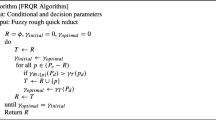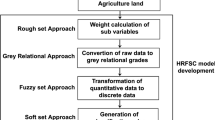Abstract
In Indian economy, agriculture is the prime vocation that avails in the overall development of the country. Tamil Nadu occupies approximately 7% of the nation's population, with 3% of water resources and 4% of land resources at the country level. The crop suitability prediction is of prime importance to enhance the nutritional security to the developing country. Based on several crops grown in a particular place, and the availability of natural resources, one can identify the suitability of crops that can be grown in a particular place. To this end, many mathematical tools were developed, but they failed to include processing of uncertainties present in the accumulated data. Therefore, in this paper an effort has been made to process the uncertainties by hybridizing rough set on fuzzy approximation space and neural network. The rough set on fuzzy approximation space identifies the almost indiscernibility among the natural resources and helps in minimizing the computational procedure on employing data reduction techniques, whereas neural network helps in prediction process. The proposed model is analysed on agriculture data of Vellore District of Tamil Nadu, India, and achieved 93% of classification accuracy in validation. The model is compared with an earlier model and achieved 8% more accuracy while predicting unseen associations.











Similar content being viewed by others
References
Malcolm B, Bruce C, Peter M (2001) Knowledge discovery in marketing: an approach through rough set theory. Eur J Mark 35:1415–1438
Zadeh LA (1965) Fuzzy sets. Inf Control 8:338–353
Pawlak Z (1991) Rough sets, theoretical aspects of reasoning about data. Kluwer Academic Publishers, Dordrecht
Molodstov D (1999) Soft set theory—first results. Comput Math Appl 37:19–31
Peters J (2007) Near sets—general theory about nearness of objects. Appl Math Sci 1(53):2609–2629
Pawlak Z (2004) Some issues on rough sets. In: Peters JF, Skowron A, Grzymała-Busse JW, Kostek B, Świniarski RW, Szczuka MS (eds) Transactions on rough sets I. Lecture notes in computer science, vol 3100. Springer, Berlin, Heidelberg
Pawlak Z (1982) Rough sets. Int J Comput Inf Sci 11:341–356
De SK (1999) Some aspects of fuzzy sets, rough sets and intuitionistic fuzzy sets. Ph.D. thesis, IIT Kharagpur
Acharjya DP (2013) Rough computing based information retrieval in knowledge discovery databases. In: Roy AK (ed) Information and knowledge management tools, techniques and practices. New-India Publishing Agency, New Delhi, pp 123–153
An A, Shan N, Chan C, Cercone N, Ziarko W (1996) Discovering rules for water demand prediction: an enhanced rough-set approach. Eng Appl Artif Intell 9(6):645–653
Duntsch I, Gediga G (1998) Uncertainty measures of rough set prediction. Artif Intell 106(1):109–137
Beynon MJ, Peel MJ (2001) Variable precision rough set theory and data discretisation: an application to corporate failure prediction. Omega 29(6):561–576
Rao DJ, Mitra P (2005) A rough association rule based approach for class prediction with missing attribute values. In: IICAI, pp 2420–2431
Anitha A, Acharjya DP (2015) Neural network and rough set hybrid scheme for prediction of missing associations. Int J Bioinform Res Appl 11(6):503–524
Qaheri H, Hassanien AE, Abraham A (1998) A generic scheme for generating prediction rules using rough Sets. In: Rough set theory: a true landmark in data analysis. Springer, Berlin, pp 163–186
Li H, Sun J, Wu J (2010) Predicting business failure using classification and regression tree: an empirical comparison with popular classical statistical methods and top classification mining methods. Expert Syst Appl 37(8):5895–5904
Liu D, Li T, Liang D (2014) Incorporating logistic regression to decision-theoretic rough sets for classifications. Int J Approx Reason 55(1):197–210
Liu D, Li T, Liang D (2012) Three-way government decision analysis with decision-theoretic rough sets. Int J Uncertain Fuzziness Knowl Based Syst 20:119–132
Liu D, Yao Y, Li T (2011) Three-way investment decisions with decision-theoretic rough sets. Int J Comput Intell Syst 4(1):66–74
Zhang X, Zhao K (2012) Bayesian neural networks for uncertainty analysis of hydrologic modeling: a comparison of two schemes. Water Resour Manag 26(8):2365–2382
Acharjya DP, Tripathy BK (2008) Rough sets on fuzzy approximation spaces and applications to distributed knowledge systems. Int J Artif Intell Soft Comput 1:1–15
Acharjya DP, Geetha Mary A (2014) Privacy preservation in information system. In: Tripathy BK, Acharjya DP (eds) Advances in secure computing, internet services, and applications. IGI Global Publishers, Hershey, pp 49–72
Acharjya DP, Roy Debasrita, Rahaman MdA (2012) Prediction of missing associations using rough computing and Bayesian classification. Int J Intell Syst Appl 4(11):1–13
Author information
Authors and Affiliations
Corresponding author
Ethics declarations
Conflict of interest
The authors declare that they have no conflict of interest
Rights and permissions
About this article
Cite this article
Anitha, A., Acharjya, D.P. Crop suitability prediction in Vellore District using rough set on fuzzy approximation space and neural network. Neural Comput & Applic 30, 3633–3650 (2018). https://doi.org/10.1007/s00521-017-2948-1
Received:
Accepted:
Published:
Issue Date:
DOI: https://doi.org/10.1007/s00521-017-2948-1




